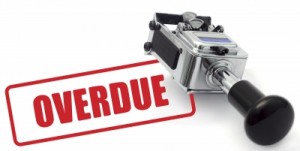Cash Flow Problems in YOUR Small Business?
Cash flow is king (or queen) in a business. As any small business knows, having positive cash flow running through your small business is the key to success. If you don’t have that, you have a major cash flow problem.
We cannot pay our staff, ourselves and our monthly bills on profit. Our bills are paid from positive cash flow. How stressful is it not having enough money in the bank at month end when staff wages and salaries are due and there is not enough money in the bank? It can be a nightmare for a small business owner!! I know from personal experience when I was a young entrepreneur. We had great customers, but at times, due to their internal systems it took a long time to get paid. At times, cash flow problems were constant.
In accounting terms there is a little formula that can tell a small business owner how successful they are at collecting money from their customers. It’s called the ‘Accounts Receivable Ratio’ and is calculated as follows:
Accounts Receivable Ratio = Total Sales for the Year / Total Accounts Receivable Outstanding
So, if your total sales for the year were $500,000 and you currently have $100,000 outstanding in Accounts Receivable, then your Accounts Receivable Ratio would be $500,000/$100,000 = 5.
We then take the 5 and divide it by 365 days per year, so 365/5 = 73.
What does 73 mean? It means that on average your customers are taking 73 days to pay their accounts. That is scary, as that statistic will seriously affect your small business cash flow.
You see, if your terms of business with your customers are for your accounts to be paid at 7, 14 or 30 days, then by your customers taking on average 73 days to pay you, that is much longer than your terms of business with them, and therefore is detrimental to the success of your small business. Therefore your, will have a cash flow problem. I promise, you will run out of cash flow if that payment history continues.
That type of Accounts Receivable Ratio could also indicate that your customers do not have a healthy regard for your small business and its success. It could also mean that your customers are not good quality and they may also have their own business issues such that you may not collect the payment at all. How much of your Accounts Receivables are you writing off as bad debts each year? Perhaps it is time to find better quality customers that have more respect for you and your business. Writing off bad debts creates an even bigger cash flow problem, as you are receiving less cash into the business than you would originally forecast.
What should you do if your Accounts Receivable Ratio is poor? The first thing is to establish a plan and internal systems and process within your small business to ensure you or someone on your team is politely following up with your customers soon after the accounts are sent to ensure they have received it, and have arranged payment. There is nothing wrong with asking your customers the question: ‘When can we expect to receive payment?’
If you do not follow up with your customers, there will often be no urgency on their part to make payment to you, regardless of your terms of business with them. Remember, it is the squeaky wheel that gets the oil, so don’t be afraid to continue contacting your customer in order that you get paid.
Take control of your business and create systems and processes to enable your customers are followed up with to ensure your accounts are paid on time, or at least close to the due date. In doing that, you will eliminate one area of business challenge that could be exacerbating your small business cash flow problem.
If you would like to learn more on how to address the cash flow issues in your business, then please go to www.adelemclay.com/free-resources and download my SPEARHead System™ – 50 Strategies For Supercharged Small Business Cash Flow.
Could some guidance from me be helpful to you? If so, please arrange a free 30 mins Skype strategy meeting with me. Here’s my calendar to book a meeting. I’d love to support you in some way to gain ‘seductive clarity’ in any aspect of your business or life.
Other articles on Small Business Cash Flow:
Small Business Cash Flow – The Ultimate Guide
Small Business Problems – Why are YOU in Business
Small Business Cash Flow Problems
Cash Flow in Business
Cash Flow Projections – Important in Business?
Projected Cash Flow – Relevant in Business?
How to Solve Cash Flow Problems: Inventory Turn






